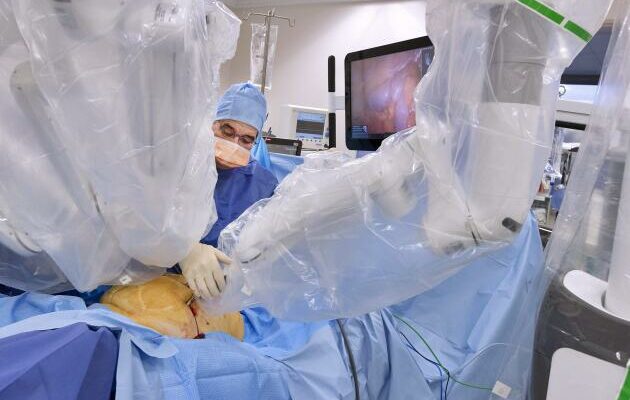Michel Lefranc has not yet finished sewing up his patient and he already knows that his intervention is a ” success “ and that this woman, who entered in the morning, will be able to leave the hospital at the end of the day. Neurosurgeon at Amiens University Hospital, he has just carried out a somewhat special operation which aims to treat isolated lower back pain. For three years, he has no longer used screws to treat this type of pain. Thanks to the robot, it will burn the small nerve endings of the joint (rhizolysis) and destroy its cartilage, allowing bone fusion (arthrodesis). Without Rosa, a robot developed in collaboration with engineer Bertin Nahum and his then company, Medtech, he would not succeed.
The surgeon from Amiens planned the entire procedure down to the smallest detail thanks to the creation of a digital twin of the patient. Once in the operating room, image and patient become one. “All you have to do is teach the robot where it is in space and where the patient is, explains Michel Lefranc, while he attaches an instrument to the end of the robot’s arm. Then the machine positions itself exactly where I need to intervene, to the millimeter. » Screens allow him to control everything.
Surgical robotics, this surgeon in his forties fell into it during his internship in Amiens. Spine surgery, placement of implants in the brains of patients with Parkinson’s disease… he carries out 95% of his operations with Rosa.
Within his hospital, he helped found a research and study group in robotic surgery (Greco), to develop robotics. Brain implant, operation for serious and progressive scoliosis in a 6-year-old child, placement of a cochlear implant in a patient suffering from deafness… the Greco teams created by the University of Picardy jointly with the Amiens University Hospital – Picardie have already achieved nine world firsts between 2017 and 2022. In December 2022, a knee prosthesis was installed using the Mako robot, from the company Smart Robotics.
Urologists have paved the way
Rosa, Mako, Hugo, Da Vinci… robots have revolutionized the practice of surgeons in just a few years. They take over the operating theaters. During a congress organized by the National Academy of Surgery, at the beginning of December 2023, there was a lot of talk about it. But, make no mistake, it is not the robots that operate, it is the surgeon who manipulates them.
In this race for innovation, the Da Vinci robot from the American company Intuitive Surgical, whose articulated arms make it look like a giant octopus, has taken a head start in what is called soft tissue surgery. . In the 1980s, the Pentagon commissioned several institutions, including NASA, to find new surgical solutions to remotely treat the wounded on the battlefield. Resulting from this research, the Da Vinci finally landed in the operating room in the early 2000s. The objective was cardiac surgery, in particular coronary bypass grafts. But it is urologists who have taken advantage of this new tool for operations for prostate or kidney cancer, because it allows them to reach anatomical areas that are difficult to access. No wonder: these same specialists were also among the first to adopt minimally invasive laparoscopic (or laparoscopic) surgery.
You have 77.08% of this article left to read. The rest is reserved for subscribers.
